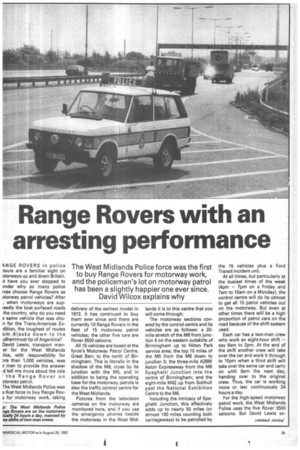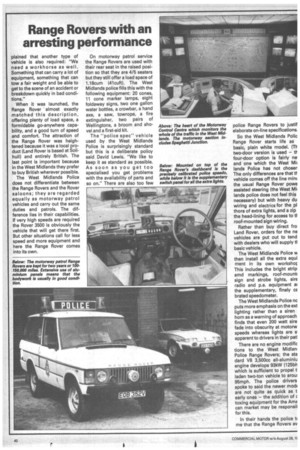Range Rovers with an arresting performance
Page 33

Page 34

Page 35

If you've noticed an error in this article please click here to report it so we can fix it.
The West Midlands Police force was the first to buy Range Rovers for motorway work, and the policeman's lot on motorway patrol has been a slightly happier one ever since. David Wilcox explains why
kNGE ROVERS in police lours are a familiar sight on otorways up and down Britain. it have you ever stopped to onder why so many police rces choose Range Rovers as otorway patrol vehicles? After , when motorways are supIsedly the best surfaced roads the country, why do you need a same vehicle that was chon for the Trans-Americas Exdition, the toughest of routes om Alaska down to the uthernmost tip of Argentina? David Lewis, transport maner for the West Midlands
■ lice, with responsibility for Dre than 1,000 vehicles, was
man to provide the answer d tell me more about the role the Range Rover on atorway patrol.
The West Midlands Police was a first force to buy Range Roy8 for motorway work, taking delivery of the earliest model in 1972. It has continued to buy them ever since and there are currently 10 Range Rovers in the fleet of 15 motorway patrol vehicles; the other five cars are Rover 3500 saloons.
All 15 vehicles are based at the force's Motorway Patrol Centre, Great Barr, to the north of Birmingham. This is literally in the shadow of the M6, close by its junction with the M5, and in addition to being the operating base for-the motorway patrols is also the traffic control centre for the West Midlands.
Pictures from the television cameras on the motorway are monitored here, and if you use the emergency phones beside the motorway in the West Mid lands it is to this centre that you will come through.
The motorway sections covered by the control centre and its vehicles are as follows: a 20mile stretch of the M6 from junction 4 on the eastern outskirts of Birmingham up to Hilton Park service area; the top 10 miles of the M5 from the M6 down to junction 3; the three-mile A38M Aston Expressway from the M6 Spaghetti Junction into the centre of Birmingham; and the eight-mile M42 up from Solihull past the National Exhibition Centre to the M6.
Including the intricacy of Spaghetti Junction, this effectively adds up to nearly 50 miles (or almost 100 miles counting both carriageways) to be patrolled by the 15 vehicles plus a Ford Transit incident unit.
At all times, but particularly at the busiest times of the week (4pm — 7pm on a Friday and 7am to 10am on a Monday), the control centre will do its utmost to get all 15 patrol vehicles out on the motorway. But even at other times there will' be a high proportion of patrol cars on the road because of the shift system used.
Each car has a two-man crew who work an eight-hour shift — say 6am to 2pm. At the end of the shift another crew will take over the car and work it through to lOpm when a third shift will take over the same car and carry on until 6am the next day, handing over to the original crew. Thus, the car is working more or lesz continuously 24 hours a day.
For the high-speed motorway patrol work, the West Midlands Police uses the five Rover 3500 saloons. But David Lewis ex plained that another type of vehicle is also required: "We need a workhorse as well. Something that can carry a lot of equipment, something that can tow a fair weight and be able to get to the scene of an accident or breakdown quickly in bad conditions."
When it was launched, the Range Rover almost exactly matched this description, offering plenty of load space, a formidable go-anywhere capability, and a good turn of speed and comfort. The attraction of the Range Rover was heightened because it was a local product (Land Rover is based at Solihull) and entirely British. The last point is important because in the West Midlands they prefer to buy British wherever possible.
The West Midlands Police does not differentiate between the Range Rovers and the Rover saloons; they are regarded equally as motorway patrol vehicles and carry out the same duties and patrols. The difference lies in their capabilities. If very high speeds are required the Rover 3500 is obviously the vehicle that will get there first. But other situations call for less speed and more equipment and here the Range Rover comes into its own. On motorway patrol service the Range Rovers are used with their rear seat in the raised position so that they are 4/5 seaters but they still offer a load space of 1.18cum (41cuft). The West Midlands police fills this with the following equipment: 20 cones, 11 cone marker lamps, eight foldaway signs, two one gallon water bottles, a crowbar, a hand axe, a saw, towrope, a fire extinguisher, two pairs of Wellingtons, a broom and shovel and a first-aid kit.
The "police spec" vehicle used by the West Midlands Police is surprisingly standard but this is a deliberate policy said David Lewis. "We like to keep it as standard as possible. As soon as you get too specialised you get problems with the availability of parts and so on." There are also too few police Range Rovers to justif elaborate on-line specifications.
So the West Midlands Polic Range Rover starts life as basic, plain white model. (Tti two-door version is used — th four-door option is fairly ne and one which the West Mil lands Police has not chosen The only differences are that th vehicle comes off the line mini. the usual Range Rover powe assisted steering (the West Mil lands police does not feel this necessary) but with heavy du wiring and electrics for the pl thora of extra lights, and a zip the head-lining for access to tl• roof-mounted sign wiring.
Rather than buy direct fro Land Rover, orders for the ne vehicles are put out to tend with dealers who will supply ti basic vehicle.
The West Midlands Police Iry then install all the extra equi ment in its own workshor This includes the bright strip amd markings, roof-mount sign and strobe lights, sire radio and p.a. equipment al the supplementary, finely ca brated speedometer.
The West Midlands Police no puts more emphasis on the ext lighting rather than a siren horn as a warning of approach finds that even 200 watt sire fade into obscurity at motorw speeds whereas lights are si apparent to drivers in their patl
There are no engine modific tions to the West Midlani Police Range Rovers; the sta dard V8 3,500cc all-aluminiu engine develops 93kW (125bh which is sufficient to propel ti laden two-ton vehicle to aroui 95mph. The police drivers spoke to said the newer mod( are not quite as quick as t early ones — the addition of c toxing equipment for the AMIE can market may be responsil for this.
In their hands the police t me that the Range Rovers av age 16.7 lit/100km (17mpg) compared with the similarly engined Rover 3500 saloons which average about 1 2,8 lit/1 0 Okm (22mpg).
Looking at top speed, acceleration and fuel consumption, the Range Rover is by no means outstanding, There are other large estate cars that can better it on all these counts and provide the same amount of load space, all for a similar price.
Beating in mind that it is primarily ratepayers' money that is being spent, can the West Midlands Police still justify the Range Rover?
David Lewis pointed out that this comparison overlooks one important fact: the Range Rover has permanent four-wheel drive with a high and low ratio transfer box giving eight forward ratios. This is primarily to give a go-anywhere ability, something the police rarely use. But where the four wheel drive is useful to the police is for towing. One raison d'être for the motorway patrol is to keep the motorway clear and this often means towing a vehicle off the carriageway. Cars are no problem but vans, lorries and coaches are a different matter.
The Range Rover's four-wheel drive and low ratios, plus high torque engine (258Nm 190Ibft at 2,500rpm) and inherent chassis strength make it a superb towing vehicle. Even for emergency purposes the recommended towing maximum for the Range Rover is six tonnes but if the circumstances demand it the West Midlands Police will exceed this in order to move a stationary vehicle just a few yards on to the hard shoulder.
Although the clutch takes a hammering during this type of manouevre it is usually accepted on the basis that this is part and parcel of a patrol car's work.
Try doing this with a conventional two-wheel drive car and see how far you get.
I spoke to a couple of police drivers and they both told me that they preferred to take out a Range Rover rather than the faster Rover 3500 saloons. They particularly liked the comfort of the Range Rover seats — important when you are spending most of the day, every day, in the car. The extra height of the Range Rover was also valued by the police drivers.
Both men spoke of the confidence that the four-wheel drive handling gives on ice or snow when driving fast. "Cornering quickly, the body rolls a bit, but the wheels always stay on the ground." For his part, David Lewis said that reliability, spare parts availability and general robustness of the Range Rover are all good. He said that early models tended to suffer from recurrent water pump problems but this seems to have been ironed out now.
The motorway cars are serviced every fortnight in the police garages; only bodywork or major warranty work is contracted out. Working 24hours a day, the cars obviously cover a great deal of mileage and 50,000-80,000 miles a year is typical. They are sold after two years or 100,000 to 150,000 miles. All their police equipment is removed and the cars disposed of via the car auctions.
Despite the 100,000-plus miles on the clock, an ex-police Range Rover is usually snapped up fairly quickly and typically fetches around £3,000. Purchasers know that for much of its life the car has been cruising at 50-60mph and that although it has been worked intensively it has been well maintained.
Earlier this week an automatic version of the Range Rover was launched using the three-speed Chrysler gearbox. The West Midlands Police has already had the opportunity to evaluate this option but for the time being it is staying with the manual boxes.
Admittedly the Range Rover is an expensive vehicle. But David Lewis and the West Midlands Police motorway patrol drivers certainly convinced me that every penny of the price is money well-spent. There is no point in choosing vehicles £3,000 cheaper if they cannot do the job. David Lewis said that in his view there is still no real rival to the Range Rover for police motorway work.
Between them, the 10 "workhorse" Range Rovers and the five "race horse" Rover 3500 saloons are doing their bit to keep the ever-increasing traffic flowing safely on their particular stretch of the M6 and adjoining motorways.








































